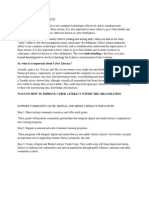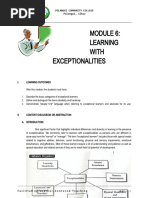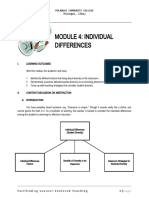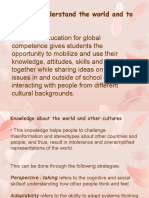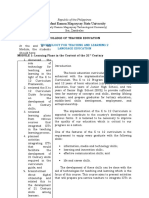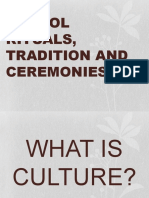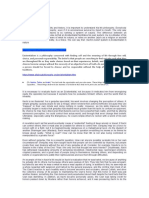67%(3)67% found this document useful (3 votes)
3K viewsMedia and Cyber or Digital Literacies: By: Atterado Corpuz Francisco Lovete
This document discusses media literacy, digital literacy, and challenges to literacy education. It defines media literacy as the ability to access, analyze, evaluate, and communicate messages across various forms. Digital literacy is defined as the ability to locate, evaluate, create and communicate information digitally. Some challenges to literacy education include measuring literacy success, determining the purpose of literacy, and how to teach these complex literacies to students and digital natives.
Uploaded by
Abby YambaoCopyright
© © All Rights Reserved
Available Formats
Download as PPTX, PDF, TXT or read online on Scribd
67%(3)67% found this document useful (3 votes)
3K viewsMedia and Cyber or Digital Literacies: By: Atterado Corpuz Francisco Lovete
This document discusses media literacy, digital literacy, and challenges to literacy education. It defines media literacy as the ability to access, analyze, evaluate, and communicate messages across various forms. Digital literacy is defined as the ability to locate, evaluate, create and communicate information digitally. Some challenges to literacy education include measuring literacy success, determining the purpose of literacy, and how to teach these complex literacies to students and digital natives.
Uploaded by
Abby YambaoCopyright
© © All Rights Reserved
Available Formats
Download as PPTX, PDF, TXT or read online on Scribd
You are on page 1/ 36
CHAPTER 5
MEDIA AND CYBER OR DIGITAL
LITERACIES
BY: ATTERADO
CORPUZ
FRANCISCO
LOVETE
• Media literacy
• What Media literacy is Not
• Challenges to Media literacy Education
• Digital literacy
• Information literacy within Digital literacy
• Socio-economical literacy within Digital literacy
• Digital Natives
• Challenges to Digital literacy Education
◦ WHAT IS MEDIA LITERACY?
◦ Aufderheide (1993) defines it as " the ability to
access,analyze, evaluate and communicate messages in a
wide variety of forms."
◦ Christ and Potter (1998) define it as " the ability to access,
analyze evaluate and create messages across a variety of
context.“
◦ Hobbs (1998) posits that it is a term used by modern
scholars to refer to the process of critically analyzing and
learning to create one's own messages in print, audio,
video, and multimedia.
◦ According to Boyd (2014) Media literacy education began
in the United States and United Kingdom as a direct result
of war propaganda in the 1930s and the rise of advertising
in the 1960s.
◦ Aufderheide (1993) and Hobbs (1998) reported " At the
1993 Media Literacy National Leadership Conference, U.S
educators could not agree on the range of appropriate goals
for Media education or the scope of appropriate
instructional techniques."
◦ The conference did, however. identify five essential
concept necessary for any analysis of Media messages.
◦ 1. Media messages are constructed.
◦ 2. Media messages are produced within economic, social,
political, historical and aesthetic context.
◦ 3. The interpretative meaning- making processes involved
in a message reception consist of an interaction between
the reader, the text, and the culture.
◦ 4. Media has unique " languages" characteristics which
typify various forms, genres, and symbol systems of
communication.
◦ 5. Media representation play a role in people's
understanding of social reality.
WHAT MEDIA LITERACY IS NOT
◦ The following is a list of actions that are often mistaken for
being representatives of Media Literacy ( Center for Media
Literacy, n.d,);
◦ ✓ Criticizing the Media is NOT, in and of itself, Media
Literacy. However, being Media literate sometimes
requires that one indeed criticize what one sees and hears.
◦ ✓ Merely producing Media is NOT media literacy
although part of being Media literate is the ability to
produce Media.
◦ ✓Teaching with Media (videos, presentation, etc.) does
NOT equal Media Literacy. An education in Media
Literacy must also includes teaching about Media.
◦ ✓ Viewing Media and analyzing it from a single
perspective is NOT Media literacy.
◦ ✓ Media Literacy does NOT simply mean knowing what
and what not to watch; it does mean "watch carefully, think
critically.)
CHALLENGES TO MEDIA
LITERACY EDUCATION
◦ * One glaring challenges to teaching Media Literacy is "
how do we teach it!"
◦ * Livingstone and Van Der Graaf (2010) identified " how
to measure media literacy and evaluate the success of
media literacy initiatives" as being one of the more
pernicious challenges facing educators in the 21st century,
for the simple reason that if we cannot somehow measure
the presence of media literacy in our students, how do we
know we have actually taught them?
◦ * More fundamental challenge to Media Literacy
Educations is one of purpose. Chris & Potter (1998) put it,
‘’ media literacy best understood as means of inoculating
children against the potential harms of the media or as a
means of enhancing their appreciation of the literacy
merits of the media?"
DIGITAL LITERACY
◦ Digital Literacy - Defined as the ability to locate,
evaluate, create and communicate information on various
digital platforms. Skills and Competences listed by
Shapiro and Hughes (1996 ) in a curriculum they
envisioned to promote computer literacy should sound
very familiar to readers today:
◦ * too literacy- competence in using hardware and software
tools:
◦ *resource literacy- understanding forms of and access to
information resources:
◦ *social-structural literacy- understanding the production
and significance of information;
◦ *research literacy- using IT tools for research and
scholarship;
◦ * Publishing literacy - ability to communicate and publish
information;
◦ * Emerging technologies literacy - understanding of new
developments in IT; and
◦ * Critical literacy- ability to evaluate the benefits of new
technologies.
◦
Lanham (1995) "digitally literate person" as being
skilled at deciphering and understanding the meanings of
images, sounds, and the subtle uses of words so that he/
she could match the medium of communication to the kind
of information being presented and to whom the intended
audience is.
Paul Gilster (1997) formally defined digital literacy as "the
ability to understand and use information in multiple
formats from a wide range of sources when it is presented
via computers," Bawden (2008) collated the skills and
competencies compromising digital literacy from
contemporary scholars on the matter into four groups:
◦ 1.Underpinnings - This refer to those skills and
competencies that "support" or "enable" everything else
within digital literacy, namely: traditional literacy and
computer/ICT literacy.
◦ 2. Background Knowledge - The large refers to knowing
where information on a particular subject or topic can be
found, how information is kept, and how it is disseminated
- a skill taken, for granted back in the day when
information almost exclusively resided in the form of
printed text.
◦ 3. Central Competencies - These are the skills and
competencies that a majority of a scholars agree on as
being care digital literacy today namely:
◦ Reading and understanding digital and non - digital
formats; creating and communicating digital information:
evaluation of information; knowledge assembly;
information literacy; and media literacy
◦ 4. Attitudes and Perspective Bawden (2008) suggests that
it is these attitudes and perspectives that link digital
literacy today with traditional literacy saying " it is not
enough to have skills and competencies, they must be
grounded in some moral framework ," specifically:
◦ Independent learning- the initiative and ability to learn
whatever is needed for a person's specific situation; and
moral/ social literacy - an understanding of correct,
acceptable and sensible behaviour in a digital environment.
INFORMATION LITERACY
WITHIN
DIGITAL LITERACY
◦ Information literacy is the general concept of
locating, evaluating, and using information, while
digital literacy specifically refers to the ability to do
those things in a digital environment.
Information literacy within digital
literacy
◦ Given the east with which digital media can be edited and manipulated, the
ability to approach it with the healthy amount of skeptisism has become a
“survival skill” for media consumers. Eshet-alkalai (2004) draws attention to
information literacy as a critical component of digital literacy as “the
cognitive skills that consumers used to evaluate information in an educated
and effective manner”. In effect, Information Literacy acts as a filter by which
consumers evaluate the veracity of the information being presented to them via
digital media and thereupon sort the erroneous, irrelevant, and biased from
what is demonstrably factual.
◦ Parts of the efforts of Digital Literacy Education should be
toward developing media consumers who think critically
and are ready to doubt the quality of the information they
receive, even if said information comes from so-called
“authoritative sources.” However, a majority of students on
Information Literacy seems to concentrate more on the
ability to search for information rather than its cognitive
and pedagogical aspects (Eshet-Alkalai,2004; Zinns,2000;
Burnett & McKinley,1998).
SOCIO-EMOTIONAL
LITERACY WITHIN
DIGITAL LITERACY
Information literacy, Eshet-Alkalai (2004) highlights a kind of
socio-emotional literacy is needed to navigate the internet,
raising question such as “how do i know if the another user in a
chat room is who he says he is?” Or “how do i know if a call
for blood donation on the internet is real or hoax?”.
◦ Socio-Emotional Literacy means being able to avoid
“traps” as well as derive benefits from the advantages of
digital communication. It involves mainly sociological and
emotional aspects of work.
◦ According Eshet-Alkalai (2004), this Socio-Emotional
literacy requires users to be “very critical, analytical
and mature”-implying a kind of richness of experience
that the literate transfers from real life to their dealings
online.
◦ Question should make us realized that there are no hard
and fast rules for determining the answers. Instead, there is
a necessary familiarity with the unwritten rules of
Cyberspace: an understanding that while the internet is
global village of sorts, it is also a global jungle of human
communication, embracing everything from truth to
falsehood, honesty and deceit, and ultimately, good and
evil.
Digitally literate users know how to avoid the traps of
cyberspace mainly because they are familiar with the
social and emotional patters of working in cyberspace—
that its is really just an outworking of human nature.
DIGITAL NATIVES
◦ Digital Natives
◦ -popularized by Prensky (2001) in reference to the
generation that has born during the information age (as
opposed to digital immigrants)- the generation prior that
acquired familiarity with digital systems only as adults)
and who has not known a world without computers, the
internet, and connectivity.
◦ -How can digital immigrants teach digital natives a literacy
they already have?
CHALLENGES TO DIGITAL
LITERACY EDUCATION
◦ -Brown (2017) noted that despite the global
acknowledgement that Digital Literacy Education is a
need, there is as of yet no overarching model or framework
for addressing all of the skills deemed necessary.
◦ CRITICAL THINKING AND THE GROUNDING OF
CRITICAL THOUGHT IN A MORAL FRAMEWORK
◦ Teach media and digital literacy integrally
◦ Master your subject matter
◦ Think multi-disciplinary
◦ Explore motivations, not just messages
◦ Leverage skills that students already have
Thank You for
listening
You might also like
- Hourglass Workout Program by Luisagiuliet 276% (21)Hourglass Workout Program by Luisagiuliet 251 pages
- The Hold Me Tight Workbook - Dr. Sue Johnson100% (16)The Hold Me Tight Workbook - Dr. Sue Johnson187 pages
- Read People Like A Book by Patrick King-Edited62% (65)Read People Like A Book by Patrick King-Edited12 pages
- Livingood, Blake - Livingood Daily Your 21-Day Guide To Experience Real Health77% (13)Livingood, Blake - Livingood Daily Your 21-Day Guide To Experience Real Health260 pages
- COSMIC CONSCIOUSNESS OF HUMANITY - PROBLEMS OF NEW COSMOGONY (V.P.Kaznacheev,. Л. V. Trofimov.)94% (212)COSMIC CONSCIOUSNESS OF HUMANITY - PROBLEMS OF NEW COSMOGONY (V.P.Kaznacheev,. Л. V. Trofimov.)212 pages
- Donald Trump & Jeffrey Epstein Rape Lawsuit and Affidavits83% (1016)Donald Trump & Jeffrey Epstein Rape Lawsuit and Affidavits13 pages
- The 36 Questions That Lead To Love - The New York Times94% (34)The 36 Questions That Lead To Love - The New York Times3 pages
- The 36 Questions That Lead To Love - The New York Times95% (21)The 36 Questions That Lead To Love - The New York Times3 pages
- Jeffrey Epstein39s Little Black Book Unredacted PDF75% (12)Jeffrey Epstein39s Little Black Book Unredacted PDF95 pages
- The 4 Hour Workweek, Expanded and Updated by Timothy Ferriss - Excerpt23% (954)The 4 Hour Workweek, Expanded and Updated by Timothy Ferriss - Excerpt38 pages
- MODULE 5: Media and Cyber or Digital LiteraciesNo ratings yetMODULE 5: Media and Cyber or Digital Literacies6 pages
- Legal and Ethical Use of Technology Lesson 8100% (1)Legal and Ethical Use of Technology Lesson 821 pages
- Building and Enhancing Curriculum ReviewerNo ratings yetBuilding and Enhancing Curriculum Reviewer6 pages
- Financial Literacy 1: Building and Enhancing New Literacies Across CurriculumNo ratings yetFinancial Literacy 1: Building and Enhancing New Literacies Across Curriculum16 pages
- Lesson 3 - New Literacies Functional Literacy and Multiliteracy100% (1)Lesson 3 - New Literacies Functional Literacy and Multiliteracy38 pages
- Application: Lesson 3: The Computer Technology Name: Vanessa Ericka A. Lara Yr. /section: BSED-3ANo ratings yetApplication: Lesson 3: The Computer Technology Name: Vanessa Ericka A. Lara Yr. /section: BSED-3A6 pages
- Chapter 1 - Introduction To 21st Century LiteracyNo ratings yetChapter 1 - Introduction To 21st Century Literacy28 pages
- Prof Ed 4: Building and Enhancing New Literacies Across The CurriculumNo ratings yetProf Ed 4: Building and Enhancing New Literacies Across The Curriculum14 pages
- Building and Enhancing New Literacies Across The Curriculum100% (1)Building and Enhancing New Literacies Across The Curriculum2 pages
- Chapter 2: The 21 Century Skill Categories: Rechelyn G. Salem-Magbanua, Maed-MathNo ratings yetChapter 2: The 21 Century Skill Categories: Rechelyn G. Salem-Magbanua, Maed-Math50 pages
- The Basics of Prosocial Behavior: Unit III: Social Literacy Lesson 2: Prosocial and Intercultural CommunicationNo ratings yetThe Basics of Prosocial Behavior: Unit III: Social Literacy Lesson 2: Prosocial and Intercultural Communication9 pages
- Multiliteracies in The Educational ReformNo ratings yetMultiliteracies in The Educational Reform9 pages
- Module 4: Individual Differences: Polangui Community CollegeNo ratings yetModule 4: Individual Differences: Polangui Community College6 pages
- Globalization and Multi-Cultural Literacy and Social LiteracyNo ratings yetGlobalization and Multi-Cultural Literacy and Social Literacy6 pages
- Profed 10 Building and Enhancing New Literacies Across The CurriculumNo ratings yetProfed 10 Building and Enhancing New Literacies Across The Curriculum45 pages
- The Learning of A Complex Subject Matter Is Most Effective When It Is Intentional Process of Constructing Meaning From Information and Experience100% (3)The Learning of A Complex Subject Matter Is Most Effective When It Is Intentional Process of Constructing Meaning From Information and Experience6 pages
- Criteria in Choosing Appropriate Assessment Tool: Group 15No ratings yetCriteria in Choosing Appropriate Assessment Tool: Group 1525 pages
- Skills To Understand The World and To Take ActionNo ratings yetSkills To Understand The World and To Take Action10 pages
- New Literacies and The 21st Century Skills100% (1)New Literacies and The 21st Century Skills13 pages
- President Ramon Magsaysay State University: College of Teacher EducationNo ratings yetPresident Ramon Magsaysay State University: College of Teacher Education13 pages
- Final Term Lecture 1 8M's, Dale, BrunnerNo ratings yetFinal Term Lecture 1 8M's, Dale, Brunner34 pages
- MODULE 7 Social Ethical and Legal Responsibilities in The Use of Technology Tools and Resources0% (1)MODULE 7 Social Ethical and Legal Responsibilities in The Use of Technology Tools and Resources29 pages
- Three Things Have Been Critical In: The Rise of The New LiteraciesNo ratings yetThree Things Have Been Critical In: The Rise of The New Literacies3 pages
- A DETAILED LESSON PLAN IN PROFED 605 HataraNo ratings yetA DETAILED LESSON PLAN IN PROFED 605 Hatara9 pages
- Financial Literacy: Reporters: Cerado, Fredisvenda Allyssa M. Josol, Kum Hyeon S. Venus, Jennifer G. Yambao, Maribeth100% (1)Financial Literacy: Reporters: Cerado, Fredisvenda Allyssa M. Josol, Kum Hyeon S. Venus, Jennifer G. Yambao, Maribeth17 pages
- Review of Related Literature and StudiesNo ratings yetReview of Related Literature and Studies15 pages
- Layout Strategies: Trece Martires City CollegeNo ratings yetLayout Strategies: Trece Martires City College13 pages
- The Only Exception: Teenage Pregnancy in The Philippines: January 2018No ratings yetThe Only Exception: Teenage Pregnancy in The Philippines: January 201829 pages
- Kelly'S Pioneer Work On Personal ConstructNo ratings yetKelly'S Pioneer Work On Personal Construct14 pages
- Television and Interpersonal Behavior Codes of Perception and ResponseNo ratings yetTelevision and Interpersonal Behavior Codes of Perception and Response11 pages
- Master Plan, Course Plan, Unit Plan: Soumya Ranjan ParidaNo ratings yetMaster Plan, Course Plan, Unit Plan: Soumya Ranjan Parida65 pages
- School Rituals, Traditions and CeremoniesNo ratings yetSchool Rituals, Traditions and Ceremonies30 pages
- What Is Accounting Theory?: Week 1 - Contemporary Issues in AccountingNo ratings yetWhat Is Accounting Theory?: Week 1 - Contemporary Issues in Accounting16 pages
- Chapter One: 1.1 What Is Logic? 1.1.1 A Branch of Philosophy What Is Philosophy?No ratings yetChapter One: 1.1 What Is Logic? 1.1.1 A Branch of Philosophy What Is Philosophy?21 pages
- Livingood, Blake - Livingood Daily Your 21-Day Guide To Experience Real HealthLivingood, Blake - Livingood Daily Your 21-Day Guide To Experience Real Health
- COSMIC CONSCIOUSNESS OF HUMANITY - PROBLEMS OF NEW COSMOGONY (V.P.Kaznacheev,. Л. V. Trofimov.)COSMIC CONSCIOUSNESS OF HUMANITY - PROBLEMS OF NEW COSMOGONY (V.P.Kaznacheev,. Л. V. Trofimov.)
- Donald Trump & Jeffrey Epstein Rape Lawsuit and AffidavitsDonald Trump & Jeffrey Epstein Rape Lawsuit and Affidavits
- The 36 Questions That Lead To Love - The New York TimesThe 36 Questions That Lead To Love - The New York Times
- The 36 Questions That Lead To Love - The New York TimesThe 36 Questions That Lead To Love - The New York Times
- Jeffrey Epstein39s Little Black Book Unredacted PDFJeffrey Epstein39s Little Black Book Unredacted PDF
- The 4 Hour Workweek, Expanded and Updated by Timothy Ferriss - ExcerptThe 4 Hour Workweek, Expanded and Updated by Timothy Ferriss - Excerpt
- Financial Literacy 1: Building and Enhancing New Literacies Across CurriculumFinancial Literacy 1: Building and Enhancing New Literacies Across Curriculum
- Lesson 3 - New Literacies Functional Literacy and MultiliteracyLesson 3 - New Literacies Functional Literacy and Multiliteracy
- Application: Lesson 3: The Computer Technology Name: Vanessa Ericka A. Lara Yr. /section: BSED-3AApplication: Lesson 3: The Computer Technology Name: Vanessa Ericka A. Lara Yr. /section: BSED-3A
- Prof Ed 4: Building and Enhancing New Literacies Across The CurriculumProf Ed 4: Building and Enhancing New Literacies Across The Curriculum
- Building and Enhancing New Literacies Across The CurriculumBuilding and Enhancing New Literacies Across The Curriculum
- Chapter 2: The 21 Century Skill Categories: Rechelyn G. Salem-Magbanua, Maed-MathChapter 2: The 21 Century Skill Categories: Rechelyn G. Salem-Magbanua, Maed-Math
- The Basics of Prosocial Behavior: Unit III: Social Literacy Lesson 2: Prosocial and Intercultural CommunicationThe Basics of Prosocial Behavior: Unit III: Social Literacy Lesson 2: Prosocial and Intercultural Communication
- Module 4: Individual Differences: Polangui Community CollegeModule 4: Individual Differences: Polangui Community College
- Globalization and Multi-Cultural Literacy and Social LiteracyGlobalization and Multi-Cultural Literacy and Social Literacy
- Profed 10 Building and Enhancing New Literacies Across The CurriculumProfed 10 Building and Enhancing New Literacies Across The Curriculum
- The Learning of A Complex Subject Matter Is Most Effective When It Is Intentional Process of Constructing Meaning From Information and ExperienceThe Learning of A Complex Subject Matter Is Most Effective When It Is Intentional Process of Constructing Meaning From Information and Experience
- Criteria in Choosing Appropriate Assessment Tool: Group 15Criteria in Choosing Appropriate Assessment Tool: Group 15
- President Ramon Magsaysay State University: College of Teacher EducationPresident Ramon Magsaysay State University: College of Teacher Education
- MODULE 7 Social Ethical and Legal Responsibilities in The Use of Technology Tools and ResourcesMODULE 7 Social Ethical and Legal Responsibilities in The Use of Technology Tools and Resources
- Three Things Have Been Critical In: The Rise of The New LiteraciesThree Things Have Been Critical In: The Rise of The New Literacies
- Financial Literacy: Reporters: Cerado, Fredisvenda Allyssa M. Josol, Kum Hyeon S. Venus, Jennifer G. Yambao, MaribethFinancial Literacy: Reporters: Cerado, Fredisvenda Allyssa M. Josol, Kum Hyeon S. Venus, Jennifer G. Yambao, Maribeth
- The Only Exception: Teenage Pregnancy in The Philippines: January 2018The Only Exception: Teenage Pregnancy in The Philippines: January 2018
- Television and Interpersonal Behavior Codes of Perception and ResponseTelevision and Interpersonal Behavior Codes of Perception and Response
- Master Plan, Course Plan, Unit Plan: Soumya Ranjan ParidaMaster Plan, Course Plan, Unit Plan: Soumya Ranjan Parida
- What Is Accounting Theory?: Week 1 - Contemporary Issues in AccountingWhat Is Accounting Theory?: Week 1 - Contemporary Issues in Accounting
- Chapter One: 1.1 What Is Logic? 1.1.1 A Branch of Philosophy What Is Philosophy?Chapter One: 1.1 What Is Logic? 1.1.1 A Branch of Philosophy What Is Philosophy?












































